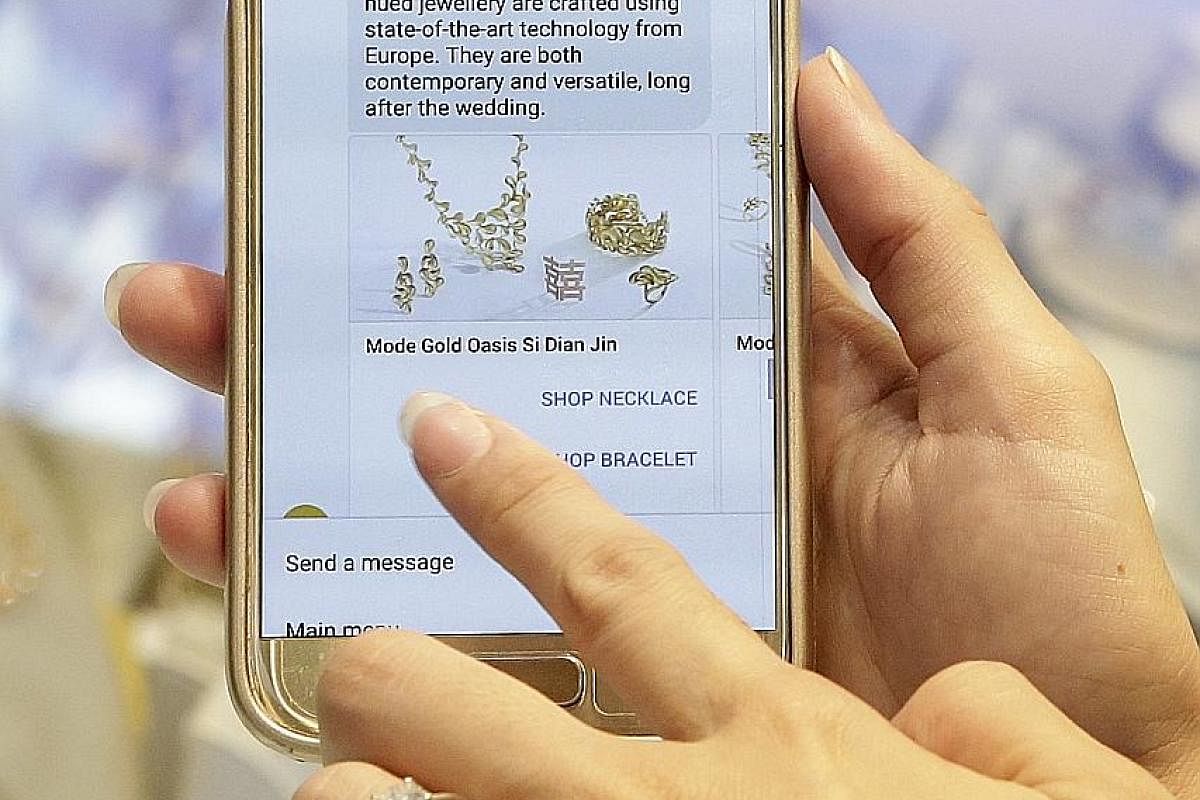-
BLING WITH SPUNK
Speaking to jeweller Goldheart's chatbot Bling feels as if I am texting a friendly sales assistant. My goal: to buy a diamond engagement ring.
I search for "Goldheart" on Facebook Messenger and easily find Bling, the home-grown brand's virtual assistant. I tap on the "Get Started" button.
Bling instantly quips, with a smiley emoji: "Are you hinting for a proposal or getting married? I can help!" It offers me two options - to find a proposal ring or take a couples quiz.
I decide to search for a ring and it asks me the name of the person I am proposing to, then offers me various options, including the Celestial diamond which it says looks like a star.
I am also taken through a series of questions, including the cut and colour of diamond of my dream band. I pick a 0.5-to 0.69-carat Celestial diamond ring that is in the D to E colour scale with an "internally flawless" clarity. Bling estimates that this will cost upwards of $8,650.
At any time, I can tap the main menu for tips, including how to plan my proposal.
The process, from searching for Bling to getting a price estimate, takes me five minutes. It also compiles a list of my preferred diamond qualities to take to a Goldheart store for hassle-free shopping.
I also discover that Bling does have some spunk. "Are you married?" I ask. It replies, logically: "I would find it hard to cross the virtual barrier!"
And when I ask if it is real, it says, with a stunned emoji: "As real as a bot can be."
Melissa Heng
Businesses develop chatbots to field queries 24/7
Welcome to the new face of retail as businesses offer chatbots to stay connected with their customers and offer information 24/7


Send a Facebook message to local bridal boutique La Belle Couture at 1am and you will get a response immediately.
The boutique's social media page, however, is not being manned by staff working round the clock to field customer inquiries. Rather, it is an automated chatbot that is clocking in the hours.
A chatbot, an artificial intelligence computer program that people can interact with using text or voice, is typically hosted on platforms such as Facebook, mobile apps or chat widgets added to websites.
La Belle Couture's chatbot runs on Facebook Messenger and provides customers with bridal package information and payment options, among other general inquiries. It can also help to make appointments.
The business' owner and managing director Teo Peiru launched the chatbot, which cost about $35,000 to develop, in May this year.
The 33-year-old estimates that more than 100 people use the chatbot each month, with about a third eventually visiting the store. She says the concept made sense as the peak period for inquiries is from 10pm to 1am and 7 to 8.30am.
"We realised customers like to message us on Facebook at hours when they are not working," she says. "The bot can reply customers efficiently 24/7 and give them a good impression of the company."
La Belle Couture is one of a rising number of fashion and beauty retailers launching their own bots here. In the past year, Japanese beauty label Shiseido, mall operator CapitaLand and local jeweller Goldheart have also come up with their versions.
The growing trend has been observed by chatbot designers as well.
Mr Hontat Ong, mobile architect at digital agency Equator, says chatbots are getting popular as it helps businesses to "extend the store experience". "Having such a feature online allows the brand to be always connected with its customers," says the 42-year-old, who has designed chatbots for companies here.
Such chatbots can be made to do a range of things, from recommending products to users researching information to helping customers create a look with product suggestions.
A chatbot that offers simple guided responses can cost $35,000 to develop while another that can interpret user-generated questions can cost from $80,000 to create.
Beauty label Shiseido's virtual beauty consultant, launched last month on Facebook Messenger, can provide product descriptions as well as conduct a skincare consultation survey with users to pinpoint skin concerns before recommending the best products available.
Mr Tatsuya Nagai, vice-president and head of prestige at Shiseido Asia Pacific, says the label created the chatbot to stay relevant in the ever-changing retail environment. "Through this chatbot, we hope we can keep in touch with and have access to younger consumers. Millennial consumers are always on their smartphones and social networks."
Chatbots, however, can do more than suggest beauty products.
CapitaLand's chatbot Sparkle, which runs on the company's mobile app CapitaStar, can help users book a cab, push promotions and make restaurant bookings. It was launched last November.
Mr Ervin Yeo, head of CapitaStar, CapitaLand, says Sparkle responds to about 1,000 queries a day.
"We also tap Sparkle to interact with our members," he says. "For example, we held a Valentine's Day Special in February that awarded members with instant Star$ for keying in code words into the chatbot."
Star$ are reward points that can be exchanged for CapitaLand vouchers. The Valentine's Day campaign had almost 13,000 members participating over two days.
Local jewellery label Goldheart's chatbot Bling, launched in July this year, runs on Facebook Messenger and helps customers with services such as engagement and wedding band selection. It also educates users on gem qualities such as the 4Cs (carat, clarity, colour and cut) of a diamond and can give an estimated price of a ring after the 4Cs have been picked.
Reminders are sent out for occasions such as Mother's Day and Christmas andthe bot will offer gift ideas when the dates approach.
Goldheart's senior brand manager Iris Tan says Bling helps "to engage today's time-strapped, fast-paced consumers".
Asked what happens if the chatbot receives irrelevant or inappropriate questions, Ms Tan says it either asks the user to rephrase the question or directs him to a Goldheart service staff who will reply him personally.
Bling, however, also has her own personality and can address some common questions users ask to tease the bot with.
"We wanted Bling to show that fine jewellery is not inaccessible or intimidating. So even if people ask certain random questions, she can give some sassy answers," says Ms Tan.
For instance, if users ask Bling how old it is, it will say that "age is just a number". It may also playfully tell them that it is "young enough to be cool, old enough to be wise".
Experts say it is not difficult to see why chatbots are becoming popular among retailers.
Mr Chayadi Karim, research associate at market research firm Euromonitor International, says they are seen as a way to automate customer service which can be a "very laborious job".
But for a chatbot to be successful, he says, it "must be sophisticated enough to provide a precise result, even if similar requests are phrased differently".
The bot should also not be crammed with too many features as this will affect its performance and relevance of its answers, he adds.
Manager Ernest Ong, 27, who is planning to buy rings for his wedding in December, used Goldheart's chatbot Bling when he wanted to browse the label's collection of wedding bands.
"I chanced on it when I was looking at its Facebook page. It's more convenient than heading down to a store since I can just ask the bot for basic information."
Join ST's Telegram channel and get the latest breaking news delivered to you.
A version of this article appeared in the print edition of The Straits Times on October 05, 2017, with the headline Businesses develop chatbots to field queries 24/7. Subscribe

